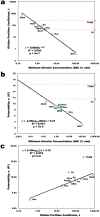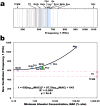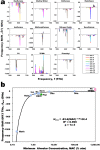Anesthetic Alterations of Collective Terahertz Oscillations in Tubulin Correlate with Clinical Potency: Implications for Anesthetic Action and Post-Operative Cognitive Dysfunction
- PMID: 28852014
- PMCID: PMC5575257
- DOI: 10.1038/s41598-017-09992-7
Anesthetic Alterations of Collective Terahertz Oscillations in Tubulin Correlate with Clinical Potency: Implications for Anesthetic Action and Post-Operative Cognitive Dysfunction
Abstract
Anesthesia blocks consciousness and memory while sparing non-conscious brain activities. While the exact mechanisms of anesthetic action are unknown, the Meyer-Overton correlation provides a link between anesthetic potency and solubility in a lipid-like, non-polar medium. Anesthetic action is also related to an anesthetic's hydrophobicity, permanent dipole, and polarizability, and is accepted to occur in lipid-like, non-polar regions within brain proteins. Generally the protein target for anesthetics is assumed to be neuronal membrane receptors and ion channels, however new evidence points to critical effects on intra-neuronal microtubules, a target of interest due to their potential role in post-operative cognitive dysfunction (POCD). Here we use binding site predictions on tubulin, the protein subunit of microtubules, with molecular docking simulations, quantum chemistry calculations, and theoretical modeling of collective dipole interactions in tubulin to investigate the effect of a group of gases including anesthetics, non-anesthetics, and anesthetic/convulsants on tubulin dynamics. We found that these gases alter collective terahertz dipole oscillations in a manner that is correlated with their anesthetic potency. Understanding anesthetic action may help reveal brain mechanisms underlying consciousness, and minimize POCD in the choice and development of anesthetics used during surgeries for patients suffering from neurodegenerative conditions with compromised cytoskeletal microtubules.
Conflict of interest statement
The authors declare that they have no competing interests.
Figures




Similar articles
-
Anesthetics act in quantum channels in brain microtubules to prevent consciousness.Curr Top Med Chem. 2015;15(6):523-33. doi: 10.2174/1568026615666150225104543. Curr Top Med Chem. 2015. PMID: 25714379
-
Computational predictions of volatile anesthetic interactions with the microtubule cytoskeleton: implications for side effects of general anesthesia.PLoS One. 2012;7(6):e37251. doi: 10.1371/journal.pone.0037251. Epub 2012 Jun 25. PLoS One. 2012. PMID: 22761654 Free PMC article.
-
Insights into the interaction dynamics between volatile anesthetics and tubulin through computational molecular modelling.J Biomol Struct Dyn. 2022 Oct;40(16):7324-7338. doi: 10.1080/07391102.2021.1897044. Epub 2021 Mar 10. J Biomol Struct Dyn. 2022. PMID: 33715591
-
Computational studies on the interactions of inhalational anesthetics with proteins.Acc Chem Res. 2010 Jan 19;43(1):103-10. doi: 10.1021/ar900149j. Acc Chem Res. 2010. PMID: 19788306 Review.
-
[Centennial for the Meyer-Overton rule: anesthetics and receptors].Masui. 2000 Feb;49(2):114-20. Masui. 2000. PMID: 10707513 Review. Japanese.
Cited by
-
Emergence of information processing in biological systems and the origin of life.Commun Integr Biol. 2024 Jul 10;17(1):2373301. doi: 10.1080/19420889.2024.2373301. eCollection 2024. Commun Integr Biol. 2024. PMID: 38993680 Free PMC article.
-
The concept of biophotonic signaling in the human body and brain: rationale, problems and directions.Front Syst Neurosci. 2025 Jun 23;19:1597329. doi: 10.3389/fnsys.2025.1597329. eCollection 2025. Front Syst Neurosci. 2025. PMID: 40626233 Free PMC article. Review.
-
Radical pairs may play a role in xenon-induced general anesthesia.Sci Rep. 2021 Mar 18;11(1):6287. doi: 10.1038/s41598-021-85673-w. Sci Rep. 2021. PMID: 33737599 Free PMC article.
-
How COVID-19 Hijacks the Cytoskeleton: Therapeutic Implications.Life (Basel). 2022 May 30;12(6):814. doi: 10.3390/life12060814. Life (Basel). 2022. PMID: 35743845 Free PMC article.
-
Modern Anesthetic Ethers Demonstrate Quantum Interactions with Entangled Photons.Sci Rep. 2019 Aug 5;9(1):11351. doi: 10.1038/s41598-019-47651-1. Sci Rep. 2019. PMID: 31383882 Free PMC article.
References
-
- Avidan MS, Evers AS. Review of clinical evidence for persistent cognitive decline or incident dementia attributable to surgery or general anesthesia. Journal of Alzheimer’s Disease. 2011;24:201–216. - PubMed
-
- Monk TG, et al. Predictors of cognitive dysfunction after major noncardiac surgery. The Journal of the American Society of Anesthesiologists. 2008;108:18–30. - PubMed
Publication types
MeSH terms
Substances
LinkOut - more resources
Full Text Sources
Other Literature Sources
Medical

